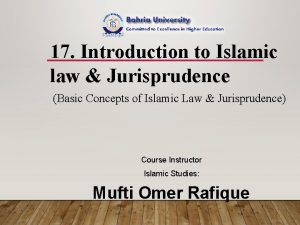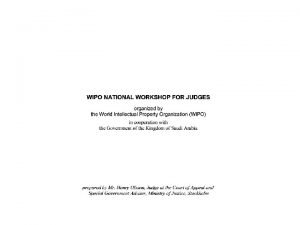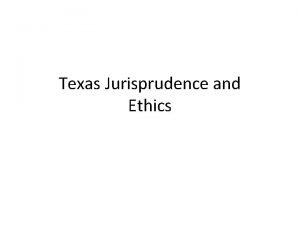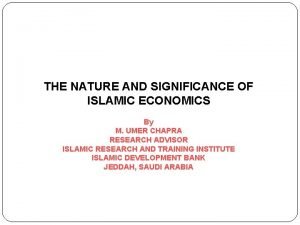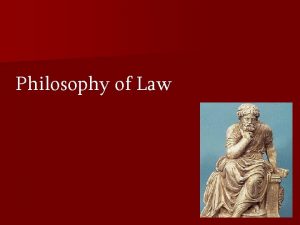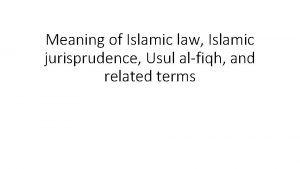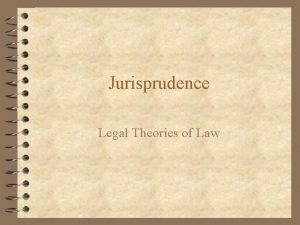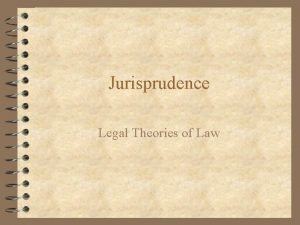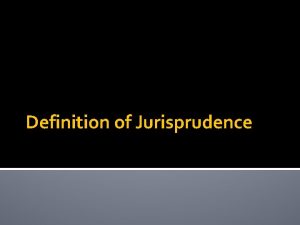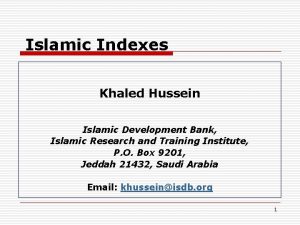18 Introduction to Islamic Law Jurisprudence Nature of












- Slides: 12

18. Introduction to Islamic Law & Jurisprudence (Nature of diffrences) Course Instructor Islamic Studies: Mufti Muhammad Omer Rafique

The Historical Development of Islamic Law � The Period of the Prophet (PBUH) � To understand this period it is worthy to know about the life of the Prophet Mohammed (PBUH) very briefly. The Prophet was born in 570 A. D. He lost his father and mother at his child hood. For that reason he was looked after by his grandfather who died when the Prophet was eight. In spite of all those lose the Prophet was strong hearted. � In 595 AD at the age of 25 he married a rich widow named Khadijah who was not simply a wife. Rather she was a disciple. Another woman who played an important role in Islam was Aisha. It seems why Attallah. N. wrote” Central to the Story of the birth of Islam are two remarkable women; Khadijah, the Prophet’s first wife and disciple, and Aisha, the girl who became his youngest wife and the source for much of hadith”

� Prophet Mohammed received the first revelation through the Angel Jibril (Gabriel) in 610 A. D. First he started teaching Islam to his friends and family. Then in 613 A. D he started teaching in public. This brought him opposition which led to the boy-cott of the Hashim, Muhammed’s clan. The purpose of that boy-cott was organized to isolate him and expose him for attack. � This led him to seek a suitable place to spread the message without obstacles. Therefore in 620 A. D, he began consultation with clans in Medina to facilitate his move there. Consequently he was visited by 12 men from Medina in 621 A. D. Again in 622 A. D he was visited by a group of 75 persons who declared their support for him and his message. This resulted in his migration from Mecca to Medina in 622 A. D. This period of departure and emigration of Mohammed and his followers from Mecca to Medina is known as thehijirahto Muslims [PBUH], and is the starting point of Islamic history.

� The Period of the Caliphs (Khalifs) � The prophet (PBUH) died in 632. The period of the caliphs followed. It was between 632 -661 A. D. Four caliphs accessed the Prophet (PBUH). They were Abu baker (573 -634 AD), Umar (584644 AD), Uthman (577 -656 AD) and Ali (600 -661 AD). � The Period of Umayyad � In the previous sections we have seen how Islam brought its domain into vast areas during the caliphate period. Thus, people within the Islamic Empire became aware of the importance, force and wielding that political power could bring. Among many factors, that was then one that led to the establishment of the Umayyad governance which was first established by Mu’a Wiyah. The Umayyad dynasty stayed on power from 661 AD to 750 AD. � During this period significant progress was made in Islamic Law. The public law sphere was standardized, codified and established while the private law spheres remained diverse. The first Islamic Jurisprudence schools, whose main purposes were to spread and teach the message of Islam, were established

� The Period of the Abbasids � The Abbasids, who are the Prophet’s (PBUH) cousins, came to the throne in 750 AD. They did that with the help of the Persians. They accused the Umayyad for distortion and dilution of the Islamic Law to suit the exigencies of the times without a proper consideration and due regard to the basic tenets of Islam. What are the achievements in Islam? � A scholarly theology evolved where in the articles and principles of Islamic faith and the Attributes of Allah were examined and conversed about, in order to ascertain the Unity of Allah the Most High. � The doctrine of constitutionalism was created. Thus every community was represented by a council of state. � Legal scholars were encouraged to respect, examine and deduce the mode of operation of the law within the Muslim Community,

� Traditions of the Prophet (PBUH) were collected and the jurisprudence of the sources of Islamic Law were codified and written. � The Quran was analyzed. � This resulted in the birth of four notable Sunni schools of legal thoughts. These are: � The school of Abu Haifa (700 -795 Ad) � The school of Malik ibn Anas (713 -795 AD) � The school of Mohammed ibn-Idris Ash Shafi (767820 Ad) � The school of Ahmad Ibn-Hanbli (780 -855 Ad) � In the next two consecutive chapters we will discuss the Sources of Islamic Law and then the school of legal thoughts.

Nature of Differences in Islamic Law � Historically, this culminated in four schools of law according to Sunni Islam, all of which are valid to follow. And the resultant difference of opinion amongst the schools is a great mercy for the community (umma). This is not only evident historically, but was explicitly articulated by many eminent imams, both early and late, such as Imams Umar ibn Abdul Aziz, Abu Hanifa, Malik, Khattabi, Nawawi, Ibn Qudama, Ibn Taymiyya, Shatibi and others. [Nawawi, Sharh Sahih Muslim; Shatibi, I`tisam; Ibn Taymiyya, Majmu` al-Fatawa] � For example, a scholar once authored a work in difference of opinion, to which Imam Ahmed ibn Hanbal responded, “Do not call it ‘The Book on Disagreement’, but rather call it ‘The Book of the Sunna. '”

� And the rightly guided Caliph Umar ibn Abdul Aziz used to say: � “It does not please me if the Companions of the Messenger of Allah (peace and blessings be upon him) did not disagree [on a particular issue], since if they all agreed on a matter and then a person did not accordingly, he would be astray. Yet if they differed on a matter, and one person took the opinion of one [of the Companions] and someone else took the opinion of another [Companion], there would be leeway in the matter. ” [Ibn Taymiyya, Majmu` al-Fatawa] � While the prophetic report “The difference of opinion in my community is a mercy” has a problematic chain of narration, its meaning was generally accepted amongst scholars of both law and hadith.

Islam and Sectarianism �Modern-day violence among sects of Islam often spring primarily from political, not religious, motives. The Quran is very clear in its guidance to Muslims that it is wrong to divide into sects and fight one another. �"As for those who divide their religion and break up into sects, you have no part of them in the least. Their affair is with Allah; He will in the end tell them the truth of all that they did. " (6: 159) �"Surely, this brotherhood of yours is a single brotherhood, and I am your Lord and Cherisher. Therefore serve me and no other. But they broke their religion into sects

� "And surely this brotherhood of your is a single brotherhood, and I am your Lord and Cherisher. Therefore fear Me and no other. But people have broken their religion into sects, each group rejoicing in that which is with them. But leave them in their confused ignorance for a time. " (23: 52 -54) � "Turn back in repentance to Him, and fear Him. Establish regular prayers, and be not among those who ascribe partners to God -- those who split up their religion, and become mere sects, each party rejoicing in that which is with itself!" (30: 31 -32) � "The believers are but a single Brotherhood. So make peace and reconciliation between your two contending brothers, and observe your duty to God, that you may receive mercy. " (49: 10 -11)

� The Quran is clear in its condemnation of sectarian violence, and also speaks against terrorism and the harming of innocent people. In addition to the guidance of the Quran, the Prophet Muhammad also warned his followers about breaking into groups and fighting one another. � On one occasion, the Prophet drew a line in the sand told his Companions that this line is the Straight Path. � He then drew additional lines, coming off the main line like branches springing from a tree. He told them that each diverted path had a shaytan along it, calling people to misguidance. � In another narration, it is said that the Prophet told his followers, "Beware! The People of the Book were split up into seventy-two sects, and this community will be split into seventy-three. Seventy-two of them will go to Hell, and one of them will go to Paradise, the majority group. " �.

�One of the paths to unbelief is to go around calling other Muslims "kafir" (unbeliever), something that people unfortunately do when they divide into sects. The Prophet Muhammad said that anyone who calls another brother an unbeliever, is either telling the truth or is himself an unbeliever for making the accusation. Since we don't know which Muslims are actually on the Straight Path, that is only for Allah to judge, we must not put such divisions amongst ourselves
 Basic concept of islamic law and jurisprudence
Basic concept of islamic law and jurisprudence Nature and nature's laws lay hid in night
Nature and nature's laws lay hid in night Importance of jurisprudence
Importance of jurisprudence Importance of jurisprudence
Importance of jurisprudence Asha certification
Asha certification Objectives of drug and cosmetic act
Objectives of drug and cosmetic act Conduct subject to reporting
Conduct subject to reporting Positivisme adalah
Positivisme adalah Pragmatic legal realism
Pragmatic legal realism Nature of islamic economics
Nature of islamic economics Newton's first law and second law and third law
Newton's first law and second law and third law Si unit of newton's first law
Si unit of newton's first law Boyle's law charles law avogadro's law
Boyle's law charles law avogadro's law
